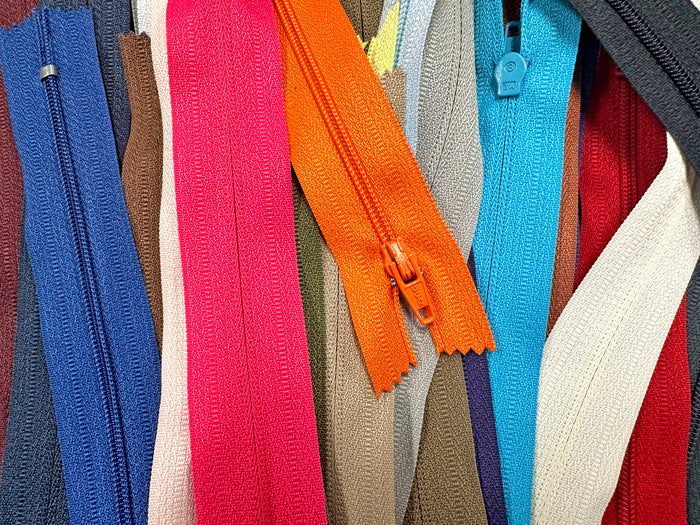How to Choose a Zipper: The Complete Guide
Need a zipper, but unsure of which one to order? You’ve come to the right place!
There are lots of factors that go into the decision-making
process when it comes to choosing a zipper. This guide will provide step by step instructions to help you navigate the process.
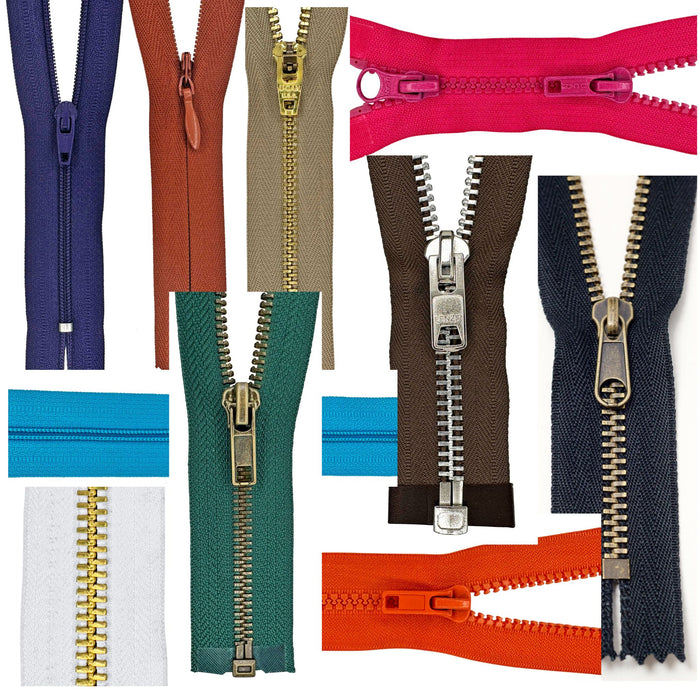
1. Separating or Closed-End Zipper?
The first thing to determine is whether you need a separating zipper or a closed-end zipper. A separating zipper is also known as an open-end zipper, and it separates completely at the bottom, like a zipper on a jacket, when unzipped. Separating zippers can separate fully into two pieces.
It’s important to determine if you need a separating zipper upfront because if you do, you will need to buy a separating zipper. You cannot convert a closed-end zipper to a separating zipper, and you cannot create a separating zipper from zipper chain. A separating zipper has a pin and box at the bottom, and these components are attached under high heat and high pressure during the manufacturing process. They, therefore, cannot be attached by hand.
If you need a closed-end zipper, you have a lot more
options. You can buy a closed-end zipper, convert a separating zipper to a closed-end zipper by sewing over the bottom, or you can create a closed-end zipper with zipper chain by the yard.
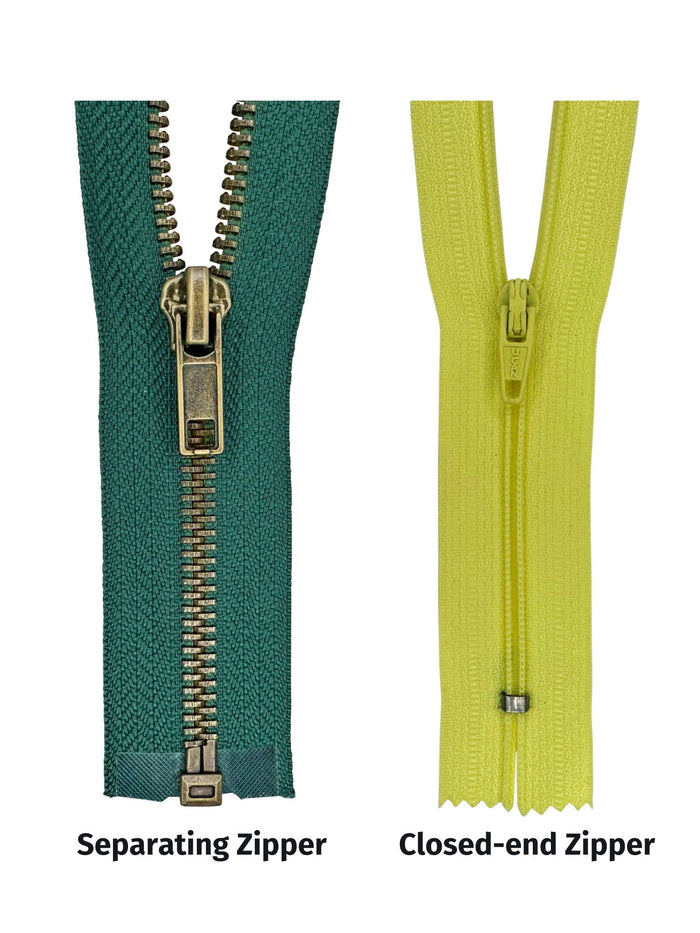
2. Zipper Tooth Material / Type of Zipper
Next, you’ll want to determine the type of zipper that you want.
The main types of zippers are nylon coil, molded plastic/molded tooth, and metal. Coil zippers include standard nylon coil zippers, invisible zippers and metallic coil zippers. Metal zippers can be made from a variety of materials, including aluminum, antique brass, antique nickel, brass, gunmetal, oxidized nickel and nickel.
If you’re replacing an existing zipper, you’ll often want to buy the same type of zipper to maintain the same look and aesthetic. This isn’t a hard rule, however, as the type of zipper used is usually a matter of personal preference.
Aesthetics aside, there are some general guidelines to follow when thinking about selecting the type of zipper material:
- Metal zippers are known for their strength and are a great choice for items requiring durability.
- Molded plastic zippers are more resistant to corrosion and are great for use in outdoor environments.
- Nylon coil zippers are sometimes referred to as “universal zippers”. They are the most flexible and are best for applications that require taking curves. For example, on cushions or luggage.
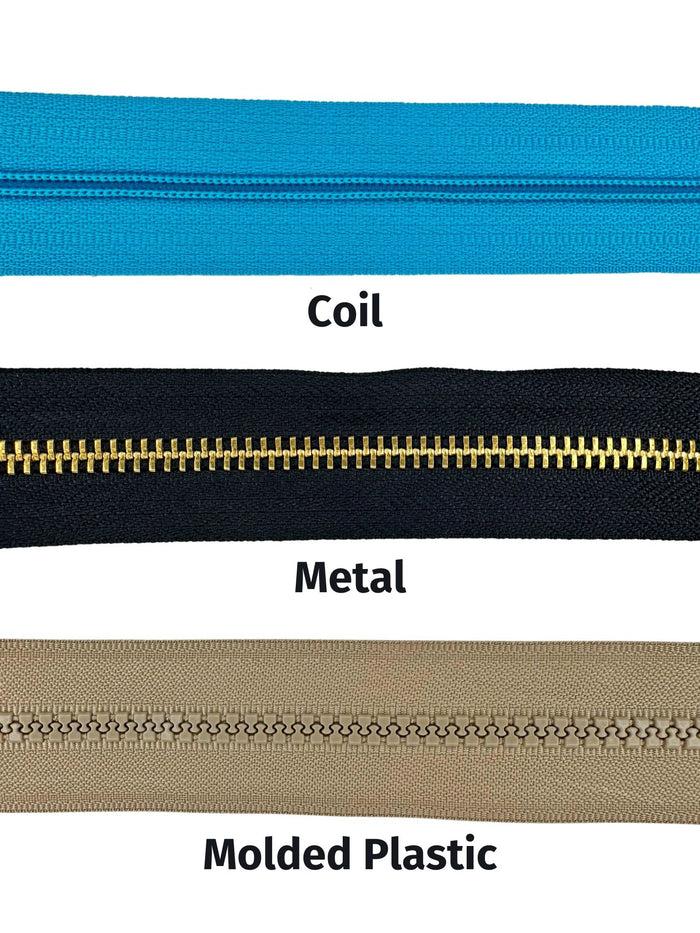
3. Zipper Size / Zipper Gauge
Next, you’ll want to determine what size/gauge zipper you need.
Zipper size – or zipper gauge – is a number that corresponds to the width of the zipper teeth, in millimeters, when the zipper is zipped. When you see the # symbol next to a number, this is referring to the zipper’s gauge.
Zipper gauge refers to how heavy duty a zipper is. The larger the number, the more heavy duty the zipper. Gauges that are close together numerically are very similar in terms of weight. For example, a #7 and a #8 are going to be very similar, with the #8 being slightly more heavy duty.
Like zipper tooth material, the zipper size that's needed isn't set in stone, but the application that the zipper will be used for must be considered in order to ensure that the zipper selected isn’t too lightweight or too heavy duty. For example, a #10 zipper on a pillow wouldn't work because that would be way too heavy duty. Alternatively, a #3 zipper shouldn't be used on a heavy duty coat.
When looking to replace an existing zipper, you’ll often want to buy the same gauge zipper or very close, unless you’re unhappy with the weight of the current zipper. You may have a #10 zipper on a jacket, for example, that you feel is too bulky. You could replace this with a #8 for something slightly less bulky, or you could go down to a #5 for something more medium weight that isn’t bulky at all.
Zipper Shipper stocks #2, #3, #4, #4.5, #5, #7, #8 and #10 zippers.
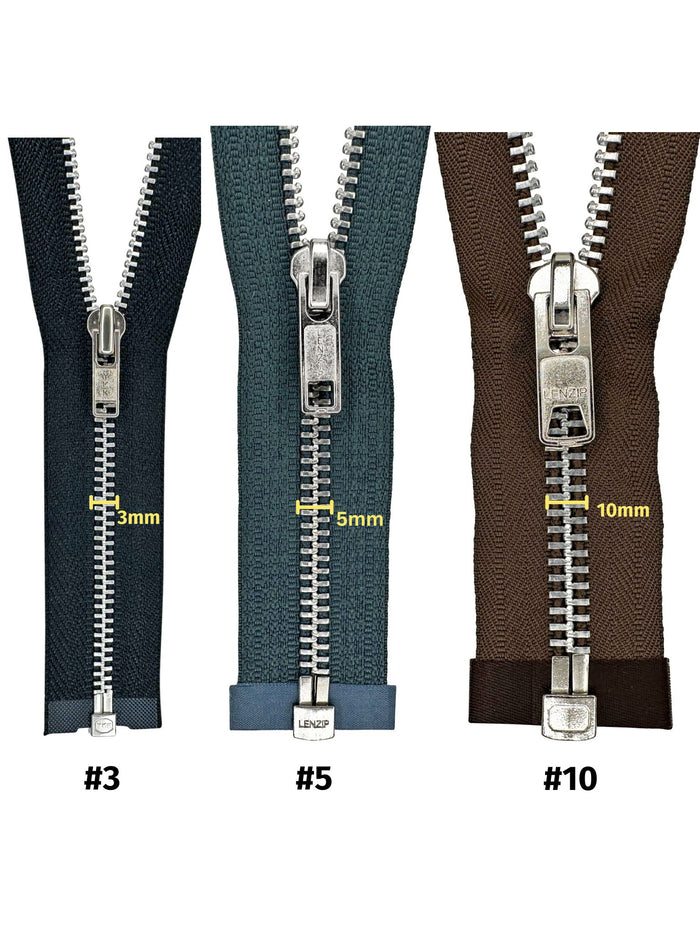
4. One-Way or Two-Way Zipper?
Whether a zipper is one-way or two-way is determined by how many sliders are on the zipper track.
Most zippers have one slider and are therefore one-way zippers. On the Zipper Shipper® website, we simply refer to this as a zipper and don’t describe it as “one-way.”
However, some zippers have two sliders and are therefore called “two-way zippers.” An example is a zipper on a longer jacket or coat, which can unzip from the bottom when the person wearing it is sitting down in order to allow room for their legs to move around more easily. Zippers for coveralls are often two-way zippers as well.
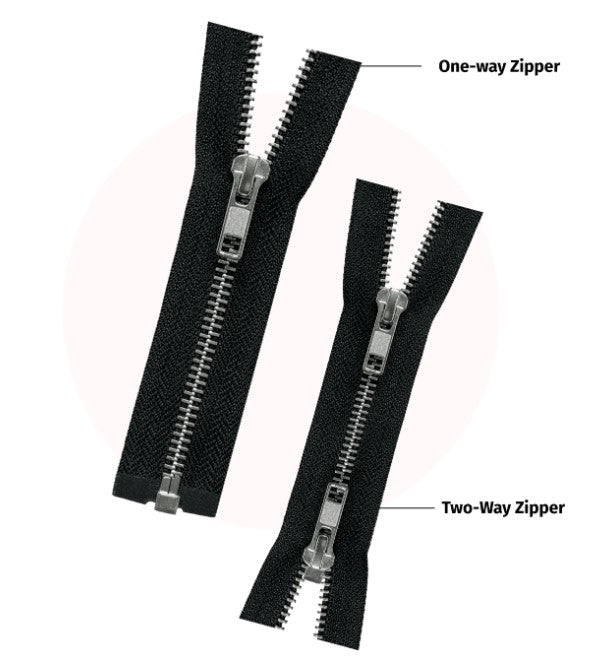
5. Zipper Style
Zipper style refers to the configuration of the zipper. The most popular zipper styles are:
- One-way closed-end
- One-way separating (or open-end)
- Two-way separating
- Head-to-head / Bag-style
- Back-to-back
- Coverall-style
- Continuous zipper chain
- Bridge-top
- Top stops each end
If you're unsure of the zipper style that you need, please refer to our Zipper Style Guide for more information.
Zipper Shipper stocks zippers ready-made in most zipper styles. Styles that are not stocked can be created with continuous zipper chain.
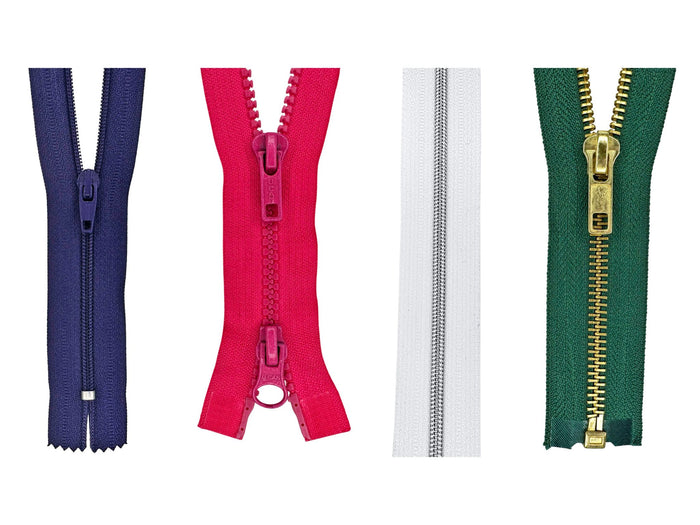
6. Zipper Length
Zipper length is often measured in inches. How you measure the length of a zipper depends on the type of zipper you’re working with. Regardless, you never include any zipper tape where there’s no chain in your measurement.
Measuring zipper length correctly is important. Please see How to Measure Zipper Length for specific instructions.
Not finding the length you need? Zipper Shipper® offers custom shortening services on most of the zippers we sell. Simply select the next length up and enter the length you need the zipper shortened to under the “Shorten to” custom field.
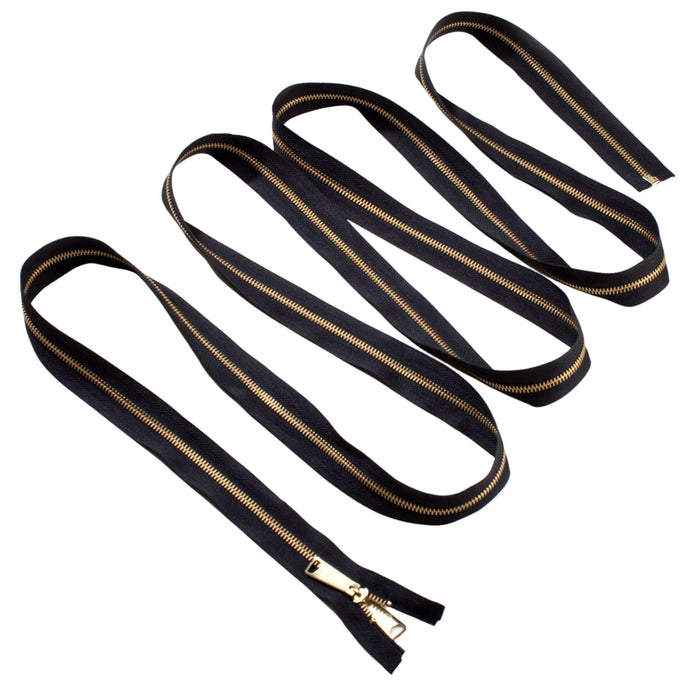
7. Zipper Color
Zipper color refers to the color of the polyester fabric on the sides of the zipper.
On molded plastic and nylon coil zippers (with the exception of metallic coil), the color of the zipper teeth will also match the fabric.
On metal zippers, the color refers to the metal zipper tape only as the zipper teeth are the color of the metal. For example, a red brass metal zipper will feature brass/gold colored teeth and red zipper tape.
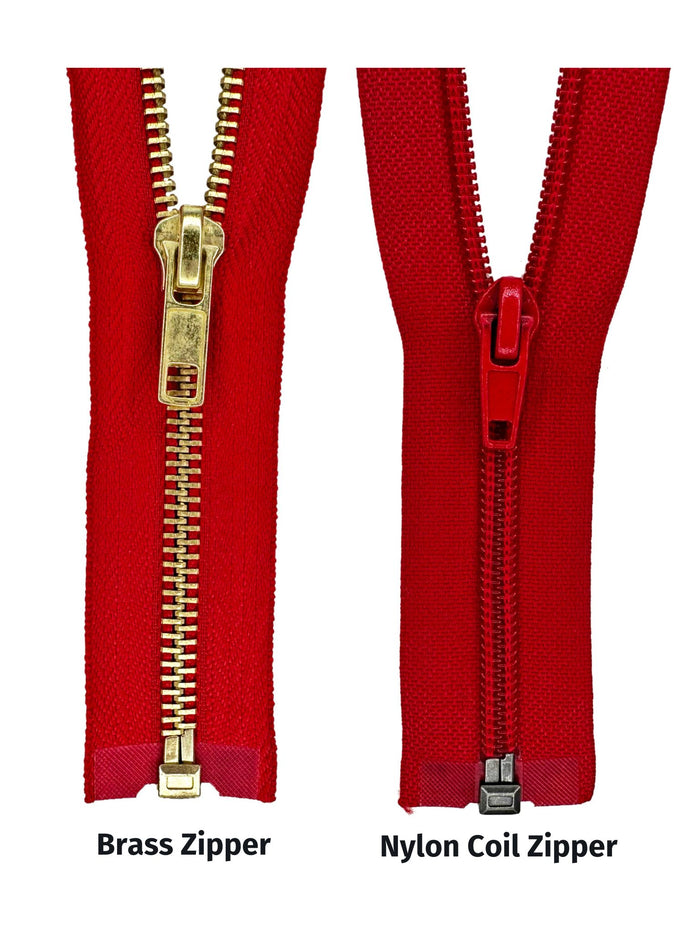
Still not sure?
Feel free to contact us with questions about your specific project. We'll be happy to help you with your zipper selection!
